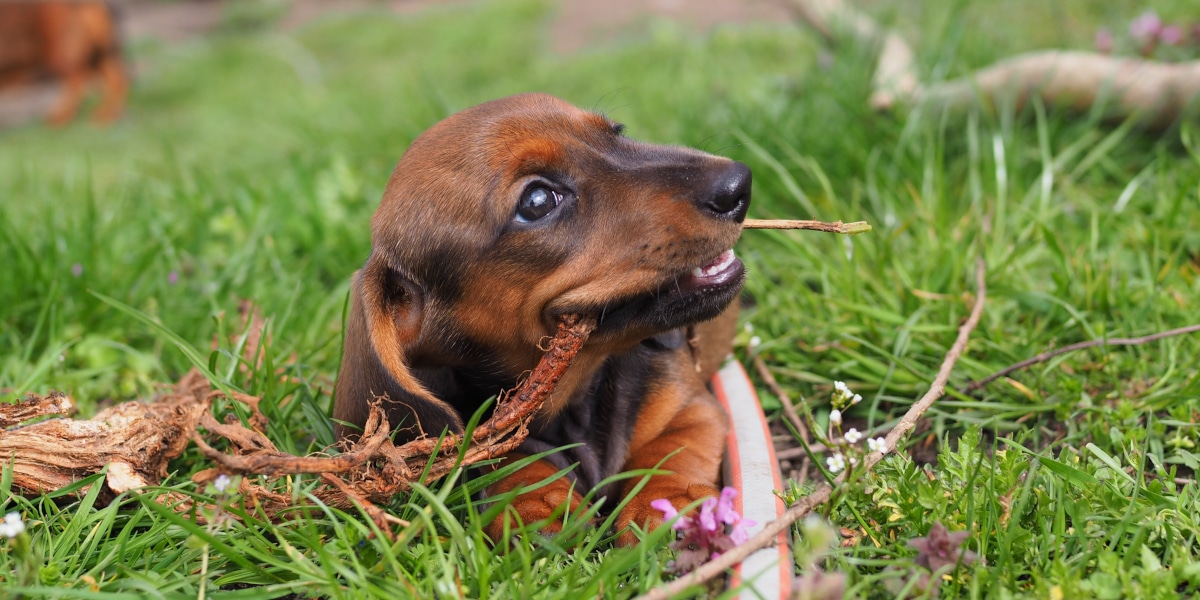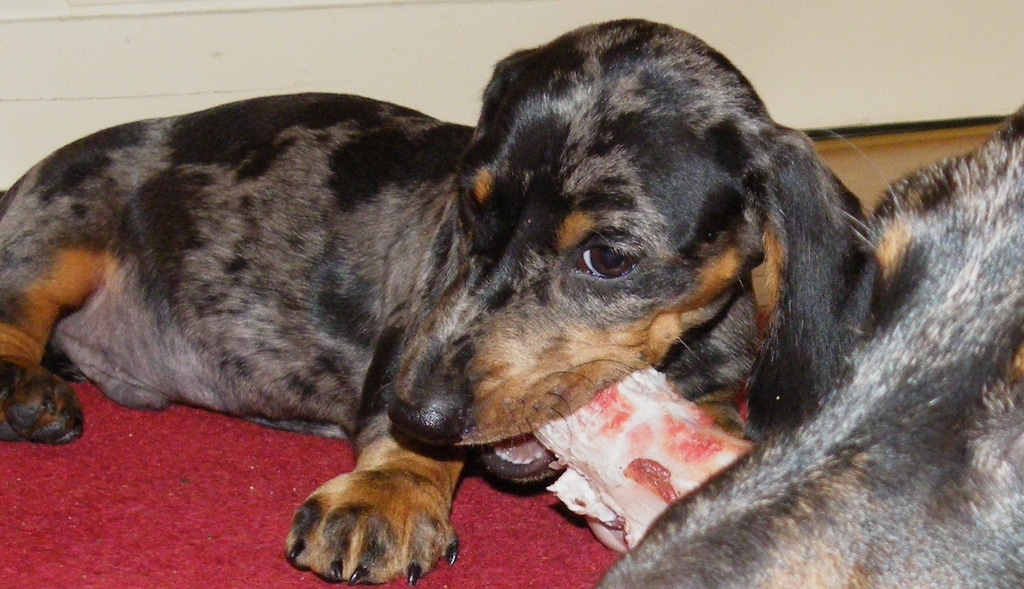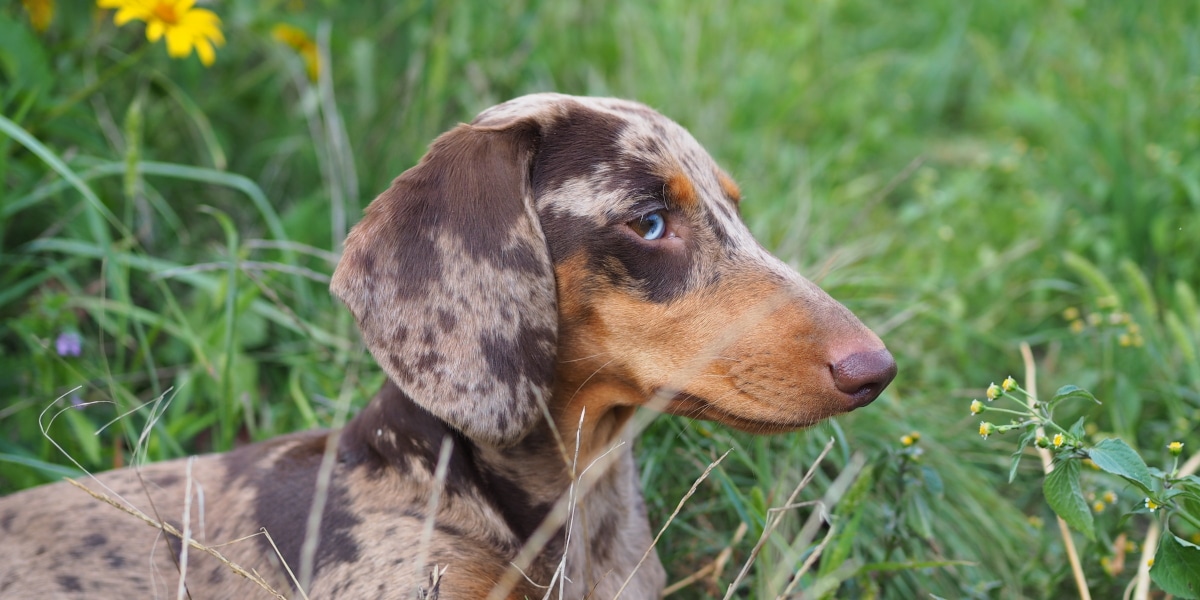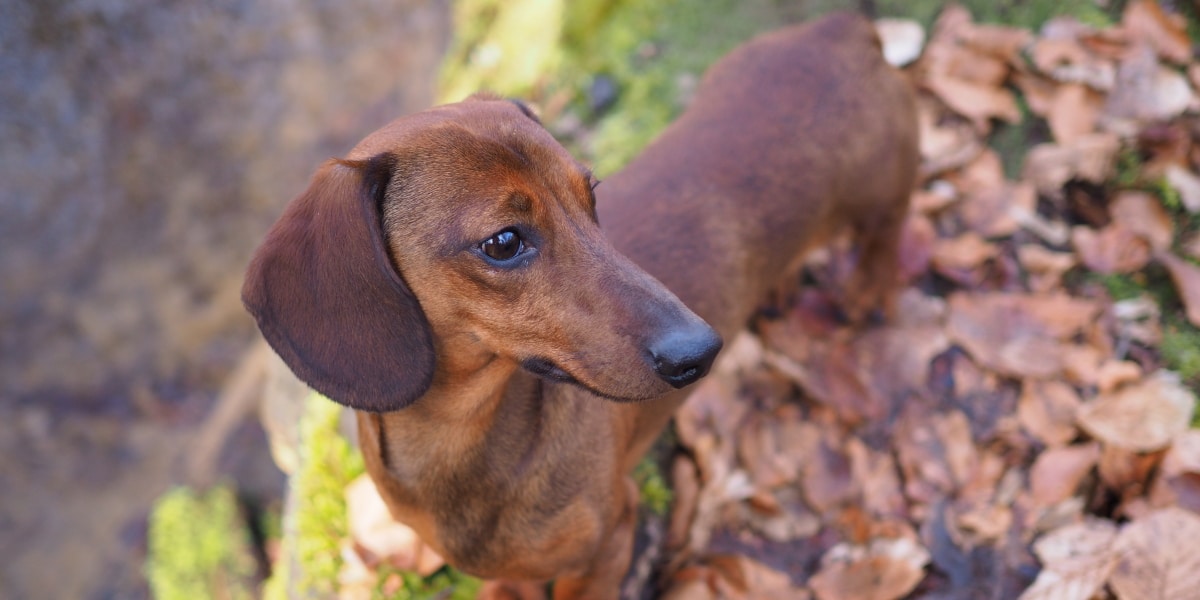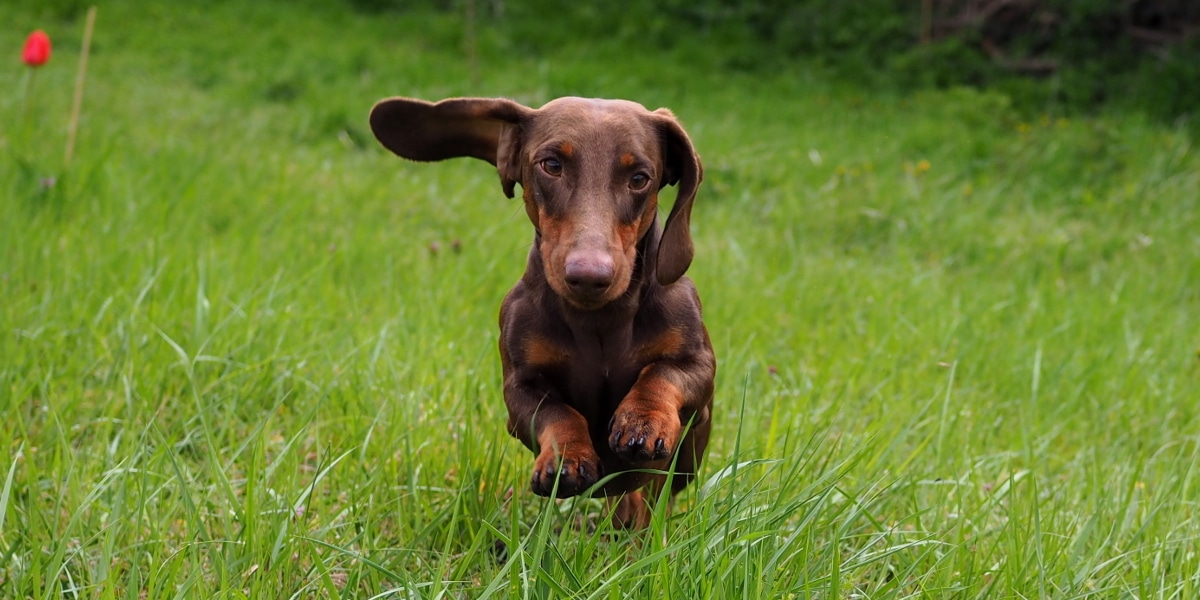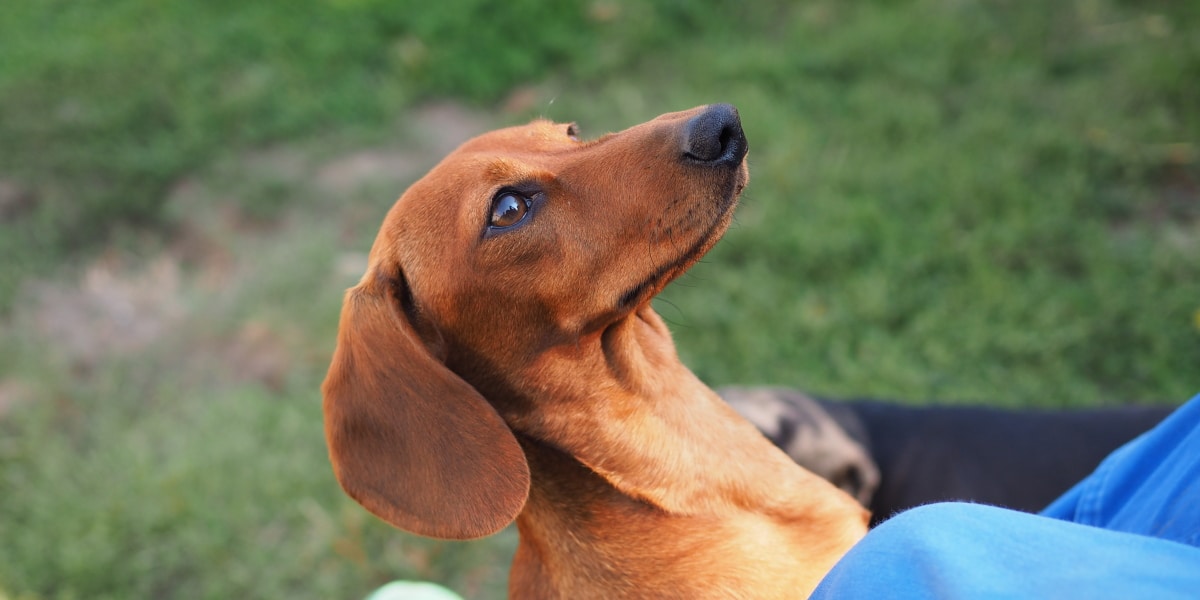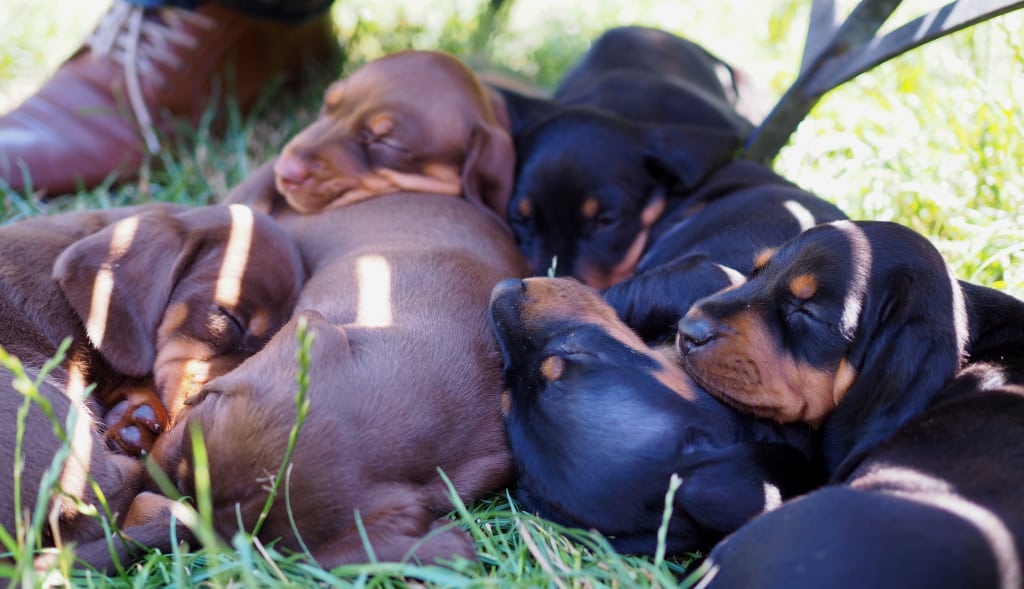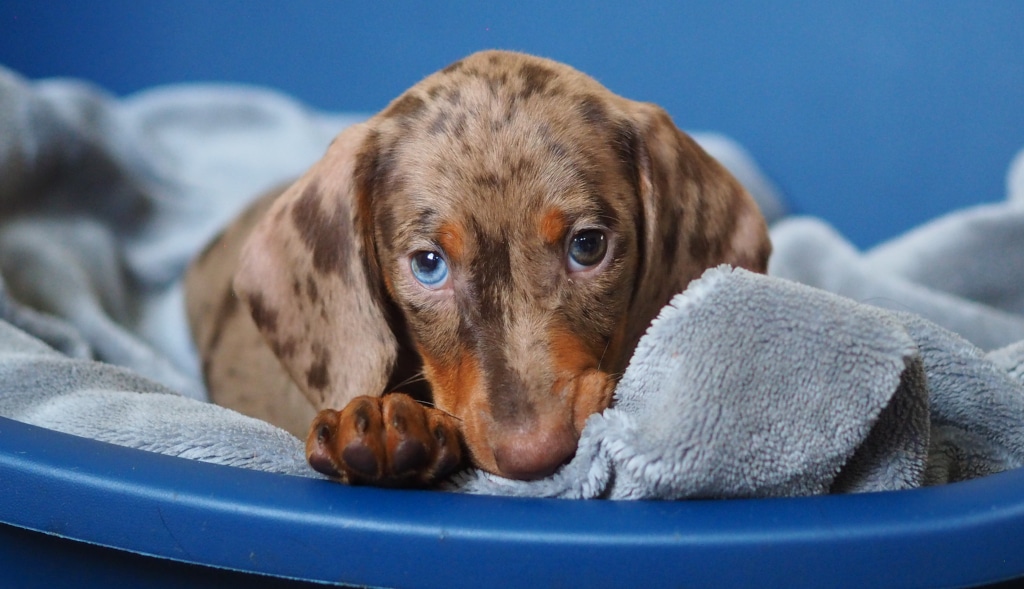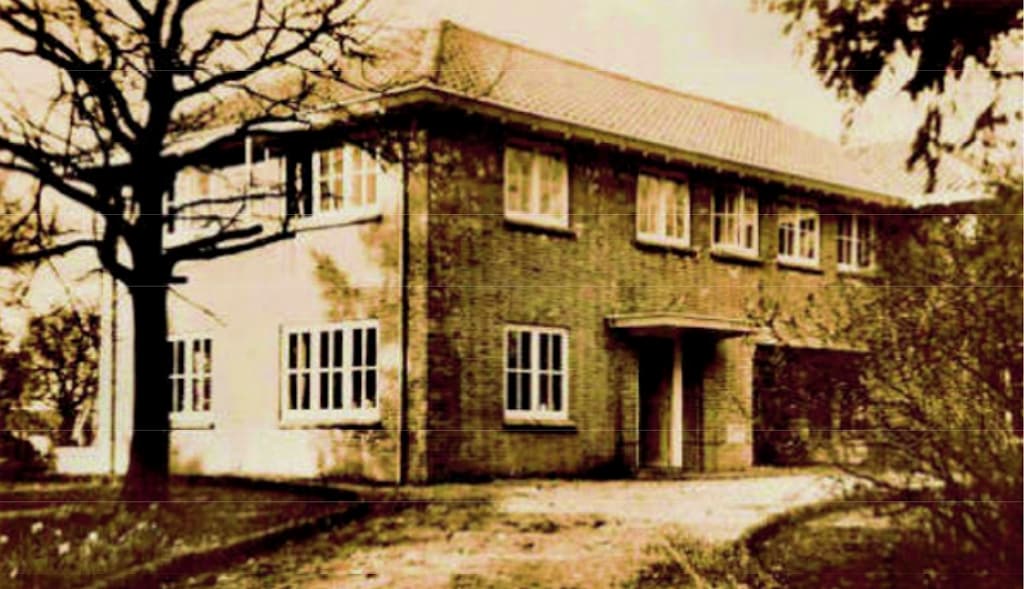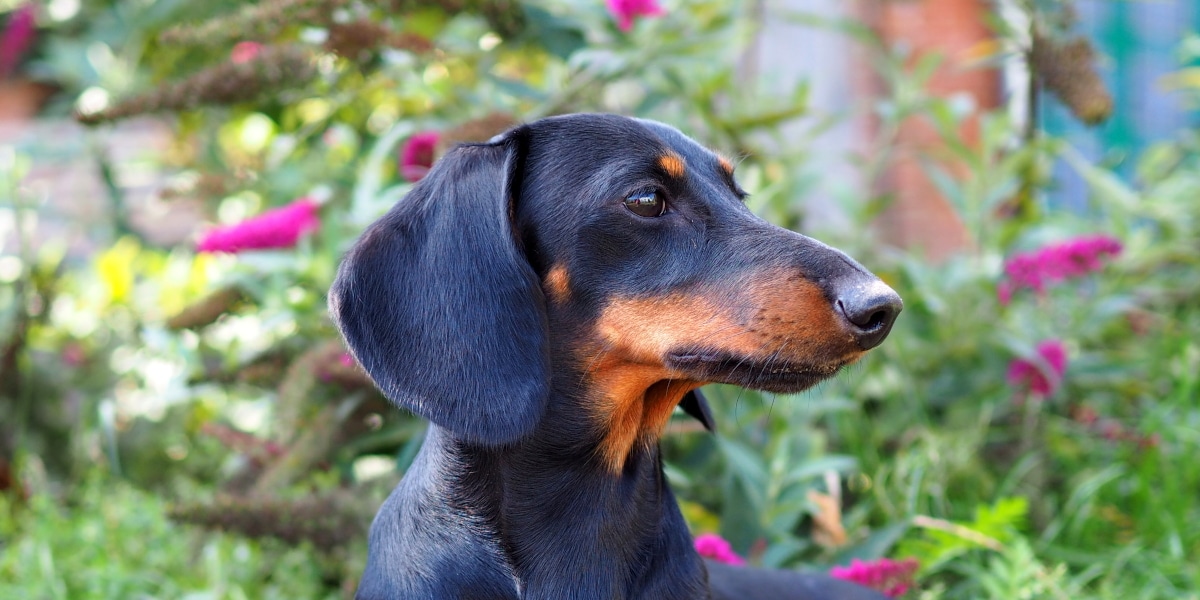The term “Dapple Dachshund” is used to describe dachshunds whose coat colour is lightened in irregularly formed patches.
Table of Contents
Breeding of Dapple Dachshunds
Lightening or marbling can affect any “coloured” area of a dog. It does not follow any recognizable geometric rule and is distributed “randomly”. It may also affect the colour of the eyes. Dapple Dachshunds may therefore have an iris that appears blue or white in whole or in part, so-called glass eyes or fish eyes, which incidentally does not affect the dog’s visual faculty and specifically does not constitute a fault of the dog.

Dapple dachshunds are not a new and certainly not a “fashion” phenomenon, but a well-known colour variety already mentioned in the first pedigree books of the German Dachshund Club founded in 1888, to which only a few breeders devoted themselves for a long time. This was due to the fact that when a dapple dachshund is involved in a mating, dappled puppies can be produced, but the question of whether, how many, and in which expression dappled puppies will be born was and is not predictable. Regularity, however, is often a decisive criterion in purebred breeding. The attempt to form a “dapple pedigree” by selective mating of dapple dachshunds with each other failed on the one hand because only a few dapple dachshunds were available for such matings, and to make matters worse, they were also quite closely related, and on the other hand because under these conditions dapple dachshunds with facial or hearing impairments appeared more frequently.
Even today, the breeding of dapple dachshunds is a somewhat scary and difficult area to understand, even for some experienced dachshund breeders. This sometimes results in an inner rejection. But all this is not witchcraft, it is simply genetics. Although it is possible to calculate statistically – and thus in relation to an infinite number of litters with an infinite number of puppies – exactly which results will come from which connections, in relation to the expectations of the individual litter this does not bring the breeder any further, because for this individual litter – with a finite number of puppies – he only has mathematical probabilities at hand. The tricky thing is that even a probability of 60% for the occurrence of dappled puppies in the litter does not guarantee that just one dappled puppy will actually be born. Theory and practice. Or the realization that a probability of only 5% of dropping dead tomorrow is 100% crap when it happens.
Hereditary Trait “Merle”
Responsible for the lightening or marbling is a hereditary disposition of the affected dog; let us call this “merle factor” or “merle gene” and refer to it as “M” for short.
As with a car, the presence of a control alone says nothing about whether the car now drives to the left or to the right. We still have to distinguish between those variants of this hereditary disposition that control the brightening in such a way that it actually occurs and those that control it in such a way that it actually does not occur. So let the hereditary disposition that triggers the brightening be called “M” and the hereditary disposition that controls that brightening does not take place “m”.
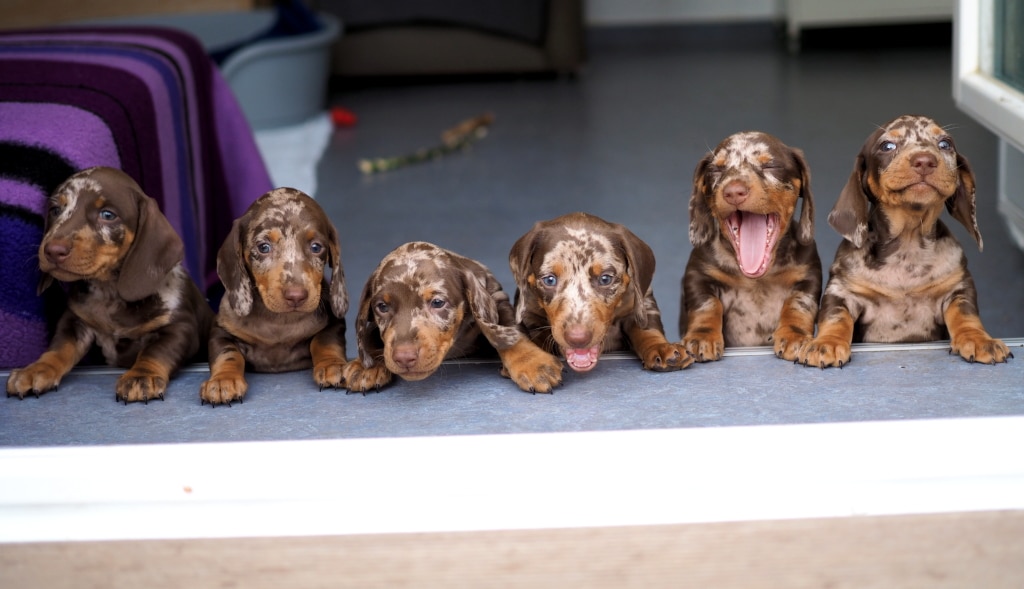
Six brown dappled dachshund puppies | G-litter of Engels Harlekin and Honey aus Dörnchen FCI
At this point, things necessarily become imprecise. It is important to remember that “m” or “M” do not describe a thing in itself, but a location in the DNA strand and that the distinction between “m” and “M” tries to convey an idea that this location is differently shaped. Today, it is assumed that “ramifications” can occur in the DNA strand at the gene locus M, which can themselves be quite differently shaped. The “m” would therefore mean that no branching occurs at location M, while “M” means that a branching occurs there. What kind of branching this is, whether long or rather short, is not yet said.
According to recent literature, it seems that the longest branches at location M cause the strongest lightening of the pigmentation, but that there are at least four variants with shorter branches that cause less strong or no lightening at all. However, I will not go into the distinction between different types of “M” here.
Inheritance of Dapple Colour Patterns
To keep things not too simple, every dog has almost every hereditary trait twice. It received one set from the father and one set from the mother when the egg and sperm united. Thus, as far as the control of lightening is concerned, a dog has received the combination of hereditary traits MM, mm or Mm from its parents.
The allele M is dominant over the allele m. The disposition to develop the dapple, if present, prevails over the disposition not to develop the dapple. A non-dapple always carries the combination mm, whether he has dapple dachshunds among his ancestors or not. That an actual non-dapple carries the disposition for dapple and could pass it on to the next generation in a hidden way, belongs to the realm of breeder’s nonsense (as, by the way, does such flourishing nonsense that dapple dachshunds only have inferior hunting dispositions). An exception may be the dogs that carry a short variant of “M” that does not lead to brightening. But even these dogs can only pass on what they have, namely the short “M” variant that does not lead to brightening, and will not produce any dappled-appearing offspring.
Health Risks
According to the current state of knowledge, the risk of visual or hearing impairment is not increased in dogs with the combination Mm, and which thus appear mackerel, compared to solid-coloured dachshunds. However, according to current knowledge, there is a higher probability of the occurrence of facial or hearing disorders in dogs with the combination MM, which does not mean, however, that these animals would always be deaf or blind. Because of the connection between pigment formation and storage processes and hearing and face, which seems strange at first sight, I have to refer to more specific literature. Nevertheless, this means for a responsible breeding with dapple dachshunds that the mating of two dapple dachshunds with each other must be avoided!

If two parents are crossed which have the combination Mm, statistically speaking (i.e. based on a very large to infinite number of offspring), a part of these offspring (25%) will always carry the combination MM and thus an increased risk of facial or hearing damage. Accordingly, the DTK prohibits the mating of two dapple dachshunds. “Statistically” means, as explained above, that among let us say five puppies of a specific litter from the combination of two dapple dachshunds, not a single one must actually carry the combination MM. However, this does not disprove the statistics, but is an individual event without any significance of its own. Just as well all puppies in another concrete litter could carry MM.
This kind of gambling at the expense of our dogs’ health must not be tolerated, especially as it would be done without necessity. A dapple dachshund may, if you breed responsibly, only be mated with a non-dapple dachshund. Then, among the offspring, only animals with the combinations Mm and mm will appear, for which special health risks do not exist. It is therefore quite possible to breed healthy dapple dachshunds if you can live with the fact that in such matings it is not foreseeable whether there will be any and how many dappled puppies in the future litter.
Effect of the “Merle Gene” on the Ground Colour
A peculiarity of the merle gene is that its lightening variant seems to have a different effect on different basic colours, or to have a different effect on the genes that in turn control the development and expression of the basic colour. In fact, the different effect of the M-gene on the pigments eumelanin and phaeomelanin is known; but here again: more details would go beyond the scope and are dispensable for the following, which refers to what can be perceived with the eyes.
The brightening effect seems to be strongest with a base colour that is actually black. Here, there are always areas clearly separated from the base colour with a considerably lightened apparent grey. The situation is similar with a brown base colour.
To recognize a dapple dachshund only from the outside, however, can be a little more demanding with a really red basic colour; but as long as the dachshund carries the disposition for black and thus shows a black nose, the dapple dachshund can always be recognized with only a little attention, at least in the youth stage – and that is when the colour of the puppy is finally registered and recorded in the pedigree and pedigree book. This does not change the fact that in adulthood some red-dappled dachshunds “pass” as red, especially under artificial light and in the short time available at shows.
There is usually a certain risk in judging the dapple characteristics only on the basis of appearance in the case of dachshunds that do not carry black and have a really pure red or almost tan ground colour. These animals can be recognized quickly and reliably by their undesirable red nose (they cannot develop black). With these animals it is really difficult to tell from the outward appearance whether they are dapple dachshunds or not. Before mating red dachshunds without a black nose with dapple dachshunds, the possibility of genetic testing available today should therefore always be used in order to definitely exclude the possibility of unintentionally mating dapple with dapple, unless it can be safely excluded that the red non-dappled has any dapple dachshunds at all among the ancestors of the pedigree generations (then it can only carry mm and can in any case be mated with a dapple dachshund that carries Mm) .
However, this reliable exclusion should only be possible if these ancestors themselves were already born at this breeder, because you may confidently assume that the DTK had good reasons to make the genetic proof of descent obligatory from 2012 and not only to rely on the information from the pedigrees, because these are also made of patient paper and are initially based on the information from the breeder.
Regulations of the DTK for Breeding Dapple Dachshunds
However, on the occasion of its delegates’ meeting in 2013, the DTK went so far as to make it compulsory for every dachshund that is to be mated to a dapple dachshund to undergo a cost-intensive examination for the presence of the M allele before mating, in order to avoid unintentional matings between two dapple dachshunds.
Irrespective of the fact that this new regulation exists and must therefore be observed: By subjecting numerous dachshunds, for which this is absolutely superfluous according to the aforementioned, to the expensive compulsory genetic examination in case of intended mating with a dapple dachshund, it harms especially the rabbit and miniature dachshunds. Every dachshund breeder who does not particularly care for dapple dachshunds, especially every owner of potential stud dogs, will shy away from these additional costs of genetic testing and thus refrain from mating his dog with a dapple dachshund. The result will be that the gene pool of these breeds will be reduced by the gene potential of the dapple dachshund for nothing and nothing again, while at the same time cross-breed matings of rabbit dachshunds with miniature dachshunds are taking place, precisely because the gene pool of these breeds has become alarmingly narrow.
This determination is also illogical in itself. If there really are “invisible” dapple dachshunds in a considerable number, then both parents would have to be examined for every mating of solid-coloured dachshunds, because two “invisible” tigers could be mated unintentionally. But that’s not all: recently, all puppies from a litter with a dappled parent must be merle tested, as long as they are not clearly dapple dachshunds. Since only a very small proportion of puppies in the DTK are used for breeding, and since they have to be tested for merle before they are used for breeding with a dappled partner for the first time, the question arises whether this makes sense. Especially the reasoning of the motion to the delegates’ meeting at that time, namely to be able to enter the correct colour (!) in the pedigree book, does not seem quite convincing to me. The “colour”, what you see, does not change. In fact, the genetic make-up behind the “colour” is entered, which is dispensable, to say the least, for dogs not used for breeding.
Another comment in passing: If (see above) processes are set in motion by the “M” trait, which can cause special features of pigment storage as well as (in the MM variant) special features (now, however, quite undesirable) in the formation of the visual faculty and hearing BUT variants of “M” exist which do not trigger these processes and thus do NOT cause special features of pigment storage (these are then the so-called cryptic tigers) doesn’t this mean that this variant of “M” can also not cause any facial or hearing impairments?
As a result, another – cryptically dappled – sow seems to be driven through the village, which conveniently only affects a small part of the members, namely those who also breed dapple dachshunds, and has zero relevance in terms of breeding and animal welfare.
Due to the extra effort required to put together suitable breeding pairs, breeding dapple dachshunds has always been somewhat more expensive, which can also be reflected in the price of the animals sold. Since the demand will not decrease, but the number of born dapple dachshunds will decrease due to the new regulations, it can be assumed that this will also have an effect on the price development.
It is a pity that on the one hand this opens the door to breeders outside the DTK, who will be happy to satisfy the demand for dapple dachshunds; but on the other hand, as explained, it will also have a negative influence on the genetic diversity, especially among the smooth-haired rabbits and miniature dachshunds within the DTK.
Reputable breeders will never claim that the colours of their Dachshunds are “rare”, nor will they overcharge depending on the colour of the dog.
Excursus: Diluted Colours in Dachshunds
Do not be tempted to buy “rare” coloured dachshunds like “Blue” or “Isabella“. You will hardly find those kind of puppies at DTK breeders. If you already have one, please do not breed with him or her. The UK Dachshund Breed Standard (Last updated August 2021) describes the dilute colours Blue and Isabella as highly undesirable.
You can never be sure what risks to the health of the puppies have been taken by breeders who claim to breed “rare colours”. Dachshunds with so-called dilute colours are at increased risk of CDA (colour dilution alopecia). CDA is a hereditary disease that has not yet been tested for. The special disease of the hair follicles, which leads to hair loss, exclusively affects dogs with dilution colours, which carry the gene for colour dilution in a homozygous form (d/d). CDA is mainly manifested by severe itching, loss of coat, skin eczema and poorly healing wounds.
Colour mutant alopecia appears to be much more common in breeds in which the dilute allele has been newly introduced (Dachshund, French Bulldog, Labrador). In these dog breeds, which have not been affected by CDA so far, we believe it is essential to avoid the risk of this hair and skin disease when breeding.
- About Dachshunds
- About Miniature Dachshunds, Rabbit Dachshunds and Rabbit Dogs
- About Breeding
- Decisions
Should a dachshund jump and climb stairs?
The Botzensteiners breeding community has given birth to many smooth-haired dachshunds since 2014. We are proud that our commitment has been honored by the German Dachshund Club with the Exhibition Breeder Pin in Gold.
We breed for joy,
but not for fun.
You will find us near Berlin, about 50 km north-east of Alexanderplatz.
Biesenthal, Germany
Over 100 of our URLs are indexed by Google Search. All content on the botzensteiners.de website, even that which does not appear in the menu, can be found directly using our website search.

